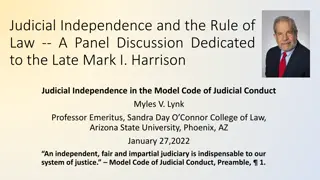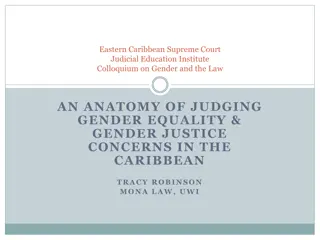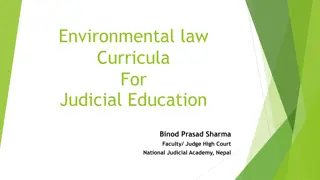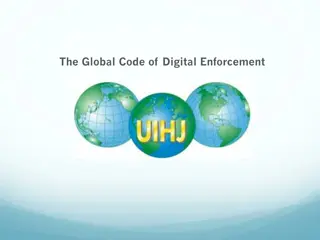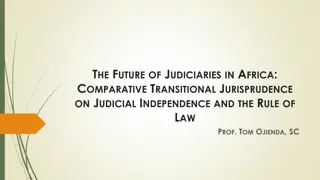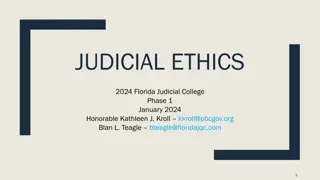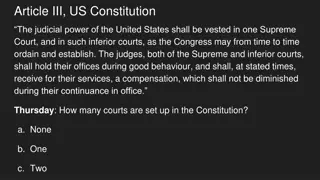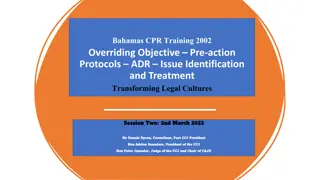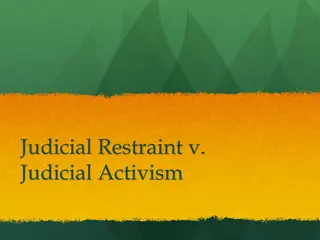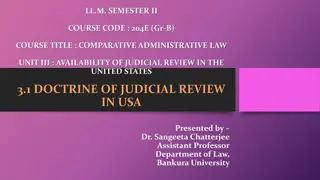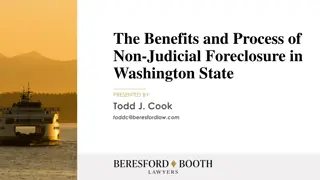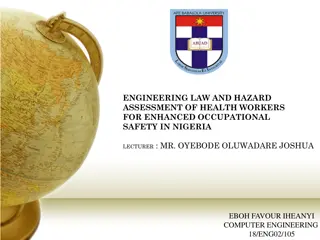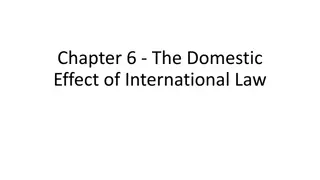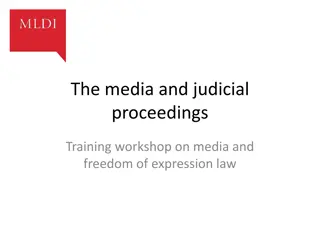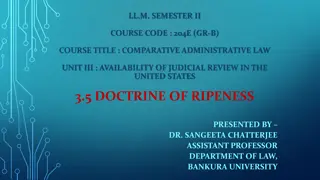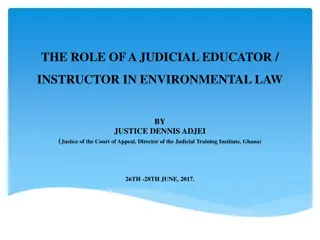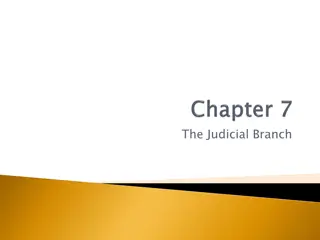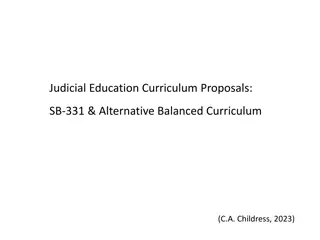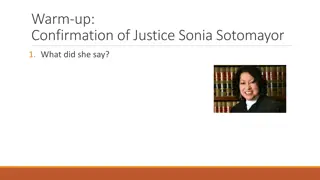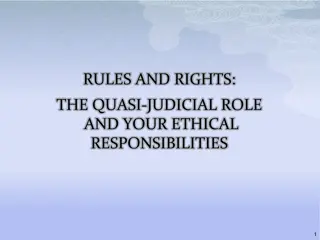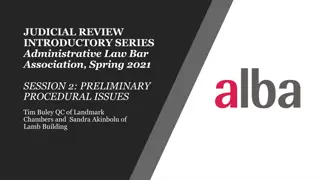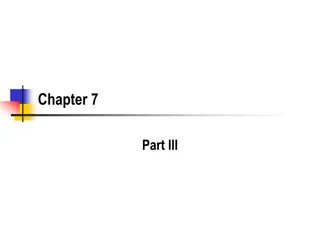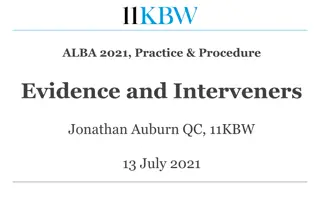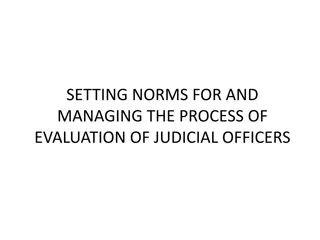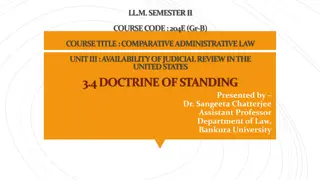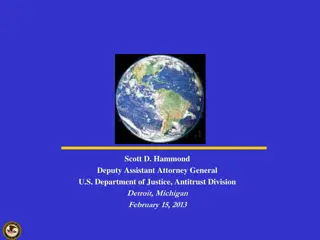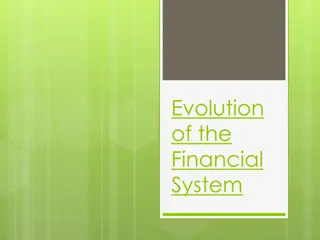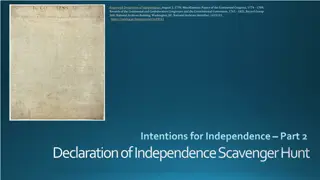Ensuring Judicial Independence for Global Enforcement
Prominent legal scholar Shimon Shetreet discusses the importance of maintaining the integrity and independence of judicial systems in the context of cross-border enforcement of judgments and awards. The key aspects include creating institutional structures, constitutional safeguards, legislative provisions, ethical traditions, and adjudicative arrangements to foster a culture of judicial independence. Emphasis is placed on both formal and informal arrangements to uphold the rule of law in a globalized world.
Uploaded on Oct 06, 2024 | 0 Views
Download Presentation

Please find below an Image/Link to download the presentation.
The content on the website is provided AS IS for your information and personal use only. It may not be sold, licensed, or shared on other websites without obtaining consent from the author. Download presentation by click this link. If you encounter any issues during the download, it is possible that the publisher has removed the file from their server.
E N D
Presentation Transcript
The Legal Position of Non-Recognized (or Partly Recognized) States Verwaltungsakademie Bordesholm and Kiel University 12-14 July 2018 Shimon Shetreet,Crossborder Enforcement and Recognition of Judgements and Awards in a Globalised World
Recognized (or Partly Recognized) States in the Post-Soviet Space under International Trade Law Private International Law International Civil Litigation
Shimon Shetreet,Crossborder Enforcement and Recognition of Judgements and Awards in a Globalised World Prof. Shimon Shetreet Greenblatt Chair of Public and International Law ,Hebrew University of Jerusalem Member Royal Academy of Arts and Science of Belgium President international Association of Judicial Independence and World Peace
Main thesis Domestic Systems must insure Integrity and Independence of the judicial System not only because it is essential element of the rule of law but also Because it is vital for cross border enforcement of judgements and arbitral awards which is essential in globalized world
The meaning od independence and Impartiality The culture of judicial independence is detailed in international Standards Example :Mt Scopus International Standards Standards of Judicial Independence 2008 of the international Assn.of Judicial independence and World Peace https://www.cristidanilet.ro/docs/MtScopusI nternationalStandrds.pdf
Creating a Culture of Judicial Independence: A wider conception The culture of judicial independence is created by five important and essential aspects: 1. creating institutional structures 2. establishing constitutional infrastructure 3. introducing legislative provisions and constitutional safeguards 4. creating adjudicative arrangements and jurisprudence 5. maintaining ethical traditions and a code of judicial conduct. 6. Emphasis on informal as well as formal arrangements
Judicial Ethics and Integrity Judicial integrity Developed in codes of judicial ethics Example : Bologna and Milano Code of Judicial Ethics of JIWP Assn. https://www.icj.org/wp- content/uploads/2016/02/Bologna-and- Milan-Global-Code-of-Judicial-Ethics.pdf
Issues Arising from Global Trade 1. Which Countries Have Jurisdiction 2. Which Legal System Should be Applied 3. Are there safeguards for investors 4. Is there access to the legal system 5. The independence and impartiality of dispute resolution mechanism ,courts arbitration tribunals
Enforcement and Recognition of Foreign Judgements and Arbitral Awards 1. In times of cross border trade and transnational economy courts must apply not only their own legal system but in some instances apply the legal doctrine of a foreign state. 2. A court may also be asked to enforce an award or judgement given by a foreign court.
Enforcement and Recognition of Foreign Judgements and Awards 3. the court must decide whether the foreign court is fair and just. 4. The decision depends on two factors: a. Independence b. Integrity Before recognizing a foreign decision
Enforcement and Recognition of Foreign Judgements and Awards Yukos Capitol Sarl v OJSC Rosneft oil Co. (2012): 1. The Russian arbitration court made a decision in the case. 2. The Dutch court decided that the Russian decision was made by a non-independent body and was therefore not enforceable. Should the English court accept the Dutch decision or should they come to their own decision? 1. The Court of Appeals decided that the English must look at the Russian court itself and not rely on the Dutch decision (no estoppel) because the criterion for judicial independence may differ by country.
Enforcement and Recognition of Foreign Judgements and Awards Merchant International Co. Ltd. v. Nationalna Kompaniia Naftogaz Ukrainy (2012) 1. The English court recognized a Ukrainian judgement. 2. Following the English courts recognition, the Ukrainian courts reversed their original decision. Should the English court set aside its initial recognition after the reversal in the Ukraine? 1. The English court of appeals decided not to disregard their original decision, as they viewed the Ukrainian reversal as illegitimate, in violation of the rule of law .
Focus Issues on Quality of Justice Justice and Efficiency
1. Review of the Justice system in modern times must give attention to fundamental values. 2. The fundamental values which lie at the foundation of the Justice System (courts and arbitration ) include: a. Efficiency of Justice b. Fairness in the Justice System
The Fundamental Values 1. Judicial Independence and Impartiality 2. Fairness and Justice 3. Efficiency 4. Maintaining Public Confidence in the Court 5. Access to the Judicial System 6. Transparency 7. Accountability
Challenging Realities 1. Court Delays 2. Caseload Crisis a. The UK in 2012 1,863,220 first instance cases were opened b. The Russian Federation opened 18,661,559 cases. c. The caseload becomes larger due to several factors: i. Volume of cases, longer trials soaring costs and increasing crime
Challenging Realities cont. 1. Constitutional Challenges 2. Budgetary challenges 3. Efficiency by Technology versus Judicial Independence 4. The players in the system: a. Lawyers b. Judges c. Litigants
Justice versus Efficiency Production of Justice cannot be done in the same standards of industrial production In a recent Israeli Supreme Court ruling, Administrative Appeal 3908/11 State of Israel and Court Administration v. The Marker Haaretz , Justice Chayut said: The concern towards the functionality of the Judicial Branch that my colleague, Justice Arbel raised in her opinion, as well as my brethren, Justices Hendel and Rubinstein in their opinion are very disturbing and merit attention...
Justice System in the Process of Globalization 1. Lawrence Friedman: National borders mean less each day. 2. Habermas: Self-Government has become problematic 3. International Tribunals and Organizations
Indicators of Justice a. Human Development Index This organization uses life expectancy, expected years of schooling and national income per capita to see what policies should be enacted. b. World Economic Forum Ranks different aspects of governmental institutions such as: public trust of politicians; division of public funds; government spending and more. These rankings allow us to see where Justice is lacking in a certain country.
Indicators of Justice c. Each year a report, Doing Business , is published facilitating and promoting the establishment of businesses. A country can learn from the others to better regulate businesses. The 2013 survey found that economies that improve in areas measured by Doing Business are on average more likely than others to also implement reforms in other areas such as: governance; health; education and gender equality. The World Bank The 2015 annual report examined 34 countries and determined how much Freedom of Contract each country had. The results show that all 34 economies have struck a balance between extreme interference and extensive freedom of contract, as well as reflecting a consensus on certain limitations that should be imposed.
Indicators of Justice d. This is the first effort to measure government openness based on the perceptions and experiences of the general public. The index presents aggregated scores and rankings as well as individual scores for each of the following dimensions of government openness: publicized laws and government data; right to information; civic participation and complaint mechanisms. oThe results show that 50% of people aren t aware of their right to information and that on the whole men are more aware than women. World Justice Project Open Index
e. European Commission for the Efficiency of Justice (CEPEJ) The CEPEJ measures many factors that may indicate the efficiency of justice Court Budgets and Income generated by the courts II. Access to courts and Legal Aid III. Confidence in the Courts IV. Lawyers and Judges V. Execution of court decisions I.
CEPEJ Report 2014 1. European countries spend on average 35 Euro per capita on the court system 2. Income fees may amount to a very small amount of the Court budget, or in some cases almost 50% of the budget. 3. The average clearance rate in European countries is 98.9%. 4. On average there are 151.3 lawyers (per 100,00 citizens) in European countries. 1. Israel on the other hand has 636.9.
Indicators of Justice A. All the different organizations measuring the different levels of Justice allow for an overview on the Macro level, allowing us to discern different trends and what we can do to change the direction of our own countries. B. Developing and encouraging such databases in Asian countries are essential to globalize trade in that part of the world .
Further discussion on Independence Judicial independence refers to Independence of the individual Judge Collective Independence of the Judiciary ahich requires examination of court administration Models of responsibility for Court Administration
Collective independence and administrative independence Judicial independence should not be confined to the personal and substantive independence of the individual judge, but should extend to the independence of the judiciary as a whole, as a corporate body. An important measuring stick in the assessment of collective judicial . independence is the administrative independence of the judiciary. This includes, for instance, supervision and control over administrative personnel, preparation of court budget, maintenance of court buildings, and the like. There are two levels for the administrative independence of the judiciary: the court level, and the central level. Both levels should be examined in order to formulate an assessment of the administrative independence of the judiciary.
Models of Responsibility for Court Administration The first model is exclusive judicial responsibility. This may be classified into two sub models: a. the individual model, vesting the responsibility in one individual judge b. the collective model, vesting the responsibility in a collegial judicial body The second model is exclusive executive responsibility as in Norway and Austria. 1. 2.
Models of Responsibility for Court Administration 3. The third model is a shared executive judicial model. This model can be classified into four sub-models: a. Vertical division of responsibility, i.e., certain matters are the responsibility of one branch throughout the whole court system and other matters are placed in the responsibility of another; b. Horizontal division of responsibility, normally the administration of the higher court will be at the responsibility of the judiciary and the executive will be entrusted with the administration of the lower courts (Australia, West Germany, Canada); c. Total joint responsibility of the executive and the judiciary for the administration of the whole court system; and, the Israeli model can be classified into this version of responsibility for court administration. d. the responsibility is vested in a collegial body in which executive and the judiciary are represented in a given proportion.
Models of Responsibility for Court Administration 4. responsibility model, whereby a collegial body representing all three branches of government (as in Brazil), and possibly other organs, such as lawyers, is vested with the responsibility over court administration. 5. A fifth model can also be identified, whereby the responsibility for court administration is vested in a separate independent organ of the state (Sweden). (According to the agencification theory of Lurie and Reichman the director of the Israeli court administration has become de facto an agency) The fourth model is a multibranch
Responsibility for Court Budgets The exclusive judicial model of responsibility for court administration accords the widest role to the judiciary in the preparation of the court budget. I. In the United States, at the federal level, the courts prepare their own budget and the judicial branch brings its budgets directly before Congress. II. An interesting model of exclusive judicial control over court budgets which has emerged is the allocation of a certain percentage of the total state budget, which is then formulated in detail and is administered by the judiciary. This is the practice in Costa Rica, where five percent of the national budget is allocated to the courts. III. In most countries, the executive has full responsibility for court budgets. into the category of complete executive control fall Uruguay, Bangladesh, Italy, South Africa and Greece.
Responsibility for Court Budgets IV. A distinction can be made between nations in which the budget, at the court level, is prepared court personnel, or the Judicial Officer, then administered by the executive, and in which the budget is prepared the executive. Falling into the are Israel, Sweden, Belgium, Uganda, Portugal and Austrla. Administration and for court budgets is maintained in Australia, Canada and the Republic of Germany. In all three countries the division of responsibility for court budgets (and court administration) is horizontal: The judiciary is responsible for the highest court of the land and the executive is responsible for other courts. by but is nations completely by latter category Norway, Finland, V. Federal
The case for shared responsibility The model of joint responsibility for judicial administration can be expressed in a judicial council which will be composed of the several branches of the government. It should be stressed that in a parliamentary system of government, where the cabinet is comprised of the leaders of the ruling party who command a majority in parliament, the problem of judicial independence from the executive is very significant, and, therefore, should receive careful attention with a view towards supporting the concept of joint responsibility of the judiciary and the executive for judicial administration.
The scope of executive Role in Judicial administration: Guiding principles Collective independence calls for the provision for protection of the judiciary vis- a-vis the legislature. One of the most controversial issues in the subject of independence of the judiciary is the delineation of the role of the executive in the administration of the courts and judicial administration and finances, and its reconciliation with judicial independence.
The scope of executive Role in Judicial administration: Guiding principles The lines delineating the boundaries of the executive role in judicial administration should be drawn in the light of several propositions: 1. The first proposition is that judicial appointments and promotions are a proper function of the executive. The first method is practised in Canada, England, Australia, Norway, and Uruguay. 2. The second proposition is that the executive may participate in the discipline of judges, but only in referring complaints against judges or in the initiation of disciplinary proceedings, not in the adjudication of such complaints.
The scope of executive Role in Judicial administration: Guiding principles 3. The third proposition is that the executive cannot have control over judicial functions or on matters concerning judges. Thus, the executive cannot have control over the division of labor among the judges, transfer of judges from one court to another, the assignment of cases to judges, the setting of cases for hearing, or the determination of sitting hours in the courts and judges' vacations. 4. The fourth proposition, is that while the physical execution of civil judgments is a function which is properly an executive function, the courts should exercise supervision over the execution process and decide all matters of judicial nature.
Mt. Scopus International Standards of Judicial Independence International Project of Judicial Independence of the International Association of Judicial Independence and World Peace 2. The Judiciary and the Executive 2.3. ( The Judiciary as a whole shall enjoy collective independence and autonomy vis-a-vis the Executive. 2.4. ) Judicial appointments and promotions by the Executive are not inconsistent with judicial independence as long as they are in accordance with Principles 4. 2.6. ) The Executive may only participate in the discipline of judges by referring complaints against judges, or by the initiation of disciplinary proceedings, but not by the adjudication of such matters. 2.7. ) The power to discipline or remove a judge must be vested in an institution which is independent of the Executive.
Mt. Scopus International Standards of Judicial Independence 2.9. ) The Executive shall not have control over judicial functions. 2.10.) Rules of procedure and practice shall be made by legislation or by the Judiciary in cooperation with the legal profession, subject to parliamentary approval. 2.11. ) The state shall have a duty to provide for the execution of judgments of the Court. The Judiciary shall exercise supervision over the execution process. 2.12. ) Judicial matters are exclusively within the responsibility of the Judiciary, both in central judicial administration and in court level judicial administration. 2.13. ) The central responsibility for judicial administration shall preferably be vested in the Judiciary or jointly in the Judiciary and the Executive.
Mt. Scopus International Standards of Judicial Independence 2.18. ) Division of work among judges should ordinarily be done under a predetermined plan, which can be changed in certain clearly defined circumstances. 2.18.1. ) In countries where the power of division of judicial work is vested in the chief justice, it is not considered inconsistent with judicial independence to accord to the chief justice the power to change the predetermined plan for sound reasons, preferably in consultation with the senior judges when practicable. 2.18.2.) Subject to 2.18.1, the exclusive responsibility for case assignment should be vested in a responsible judge, preferably the President of the Court. 2.19. ) The power to transfer a judge from one court to another shall be vested in a judicial authority according to grounds provided by law and preferably shall be subject to the judge s consent, such consent not to be unreasonably withheld. 2.26. )The Executive shall not have the power to close down, or suspend, or delay, the operation of the court system at any level.
Mt. Scopus International Standards of Judicial Independence 9. The Internal Independence of the Judiciary 9.1) In the decision-making process, a judge must be independent vis-a-vis his judicial colleagues and superiors. 9.2 ) Any hierarchical organization of the judiciary and any difference in grade or rank shall in no way interfere with the right of judges to pronounce their judgments freely.
The Achievement of Self- Governance in the U.S. Federal Judiciary The United States -An example for the development of self- judicial governance in the Federal Judiciary, and a gradual process for building a culture of judicial independence. 1. 1788 -The U.S. Constitution was ratified . The need for an institutional blueprint and accompanying details for court system management and administration prompted the Congress in the following year to draft and submit to President George Washington An Act to Establish the Judicial Courts of the United States 2. 1849 - Congress passed an Act that transferred fiscal oversight of the court system from the Treasury to the new Department of the Interior (DOI).
The Achievement of Self- Governance in the U.S. Federal Judiciary 3. 1870 - Governance was transferred to the Department of Justice. 4. 1891 The Judiciary Act passed, which authorized a tier of nine intermediate circuit courts of appeals to relieve the Supreme Court of its increasingly burdensome obligations and swelling caseload. 5. 1939 - Responsibility for the administration of courts and judges was transferred from the Executive to the 6. 1948 -The Judicial Conference of the United States was established. It took one hundred and forty years for the United States Federal Judiciary to undergo a process of a gradual change from being under total control of the Executive to attaining the stage of self judicial governance system. circuit-riding Judicial branch.
Relationship of the Judiciary and the Executive and Legislative: The Preferred Model Partnership and Dialouge The Principle of Mutual Respect between the Branches of Government Post Decisional Independence: Legislative Reversal of Judicial Decisions and Executive Enforcement of Judgments Executive Delegated Legislation and Preemptive Actions in Pending Matters before the Courts Judicial Role in Society Procedural Tools and Substantive Tests for Fine Tuning of Judicial Roles in Society
Conclusion I Domestic Systems must insure Integrity and Independence of the judicial System not only because it is essential element of the rule of law but also Because it is vital for cross border enforcement of judgements and arbitral awards which is essential in globalized world
Conclusion II Important to balance between an efficient Justice System and judicial independence It is essential to maintain the fundamental values of justice III. In the conflict between Efficiency and Fairness- fairness should win IV. Importance of judicial independence impartiality and fairness for enforcement of judgements in other jurisdictions I. II.
Conclusions III Adapting an appropriate model of responsibility of court adminidtration according to local traditions and system of government II. Beware of managerial unrestrained powers in court management III. Essential foundation to insure efficiency: develop data base and collect data on justice system similar to European council I.


